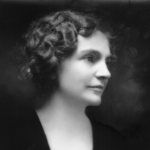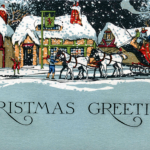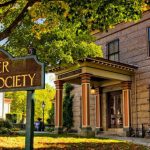The FRHS has maintained a longstanding relationship with the Adams House—a.k.a. Home for Aged People—founded in Fall River in 1891 to provide exemplary care in a lovely, private home-like environment to elderly residents; all three of our former curators spent their final days there, as did countless FRHS members.
In fact, in the 1960s, when the Adams House accurately recognized that the heavy, wine-colored velvet draperies—very Victorian—that hung in their first floor parlor were rather funereal for the residents, they immediately thought to donate them to the FRHS.
The fabric was wonderfully faded to a mellow hue that only comes with age—the windows must face the right direction, the sun being screened just enough to fade, but not strong enough to rot—they hung here for decades, until being replaced with the more appropriate, period-inspired window treatments, installed when the rooms were restored.
Adams House was a truly extraordinary place with a fascinating history and will be sorely missed by many people, myself included.
I have some really great memories of the place, having first visited in the company of my dear friend and mentor, Florence Cook Brigham (1899-2000), in the late 1970s.
The residents of Adams House—despite being called by the archaic term “inmates” during the first decades of its history—were not patients, in the hospital or nursing-home sense of the word, though many of them were, or inevitably became, infirmed and required considerable care; they were family, and were always treated as such.
Therein lies the difference.
I was fortunate to have the opportunity of personally witnessing the companionship and compassionate care provided by the very special staff at Adams House on countless occasions, having spent a great deal of time there over the years, especially so when visiting members of the FRHS who were in residence.
In many ways, the place could be likened to some grand Victorian residential hotel, favored by a refined clientele made up of the quintessential Yankee old maids (and sometimes, not), widows, and in fewer numbers, their male counterparts … with all the idiosyncrasies that came with them.
Residents habitually furnished their rooms with things selected from their former homes, and the public spaces held a wonderful hodge-podge of period pieces, either the gifts of various benefactors when the building was first constructed, having been in situ for decades, or those left by former residents, long deceased. The first-floor parlor, on the north side of the building, was a large, beautifully appointed room, comfortably furnished and dominated by an impressive mahogany-cased tall clock, presented to Adams House as a memorial gift; on the mantelpiece, a medium-sized gilt brass carriage clock, its porcelain face bearing the inscription: “C. E. Gifford & Co. Fall River, Mass.”
It was refined, and very Fall River … “old” Fall River, to be exact.
Both clocks—carriage and tall-case—are now in the collection of the FRHS. In fact, the beautiful tall-case clock was purchased at auction by BayCoast Bank for donation to the Society, where it will be preserved; the FRHS is extremely grateful for their generosity and interest.
As in a private home, there were trinkets and bric-a-brac on display at Adams House—with the same provenance as the furnishings, no doubt—often presented on crocheted doilies, as has long been the custom. At the FRHS Annual Meeting, held in the Adams House parlor in late May, 2018, I noticed a hand-painted porcelain plate on a hallway étagère—the hand looked familiar to me, and I suspected I knew the artist. Sure enough, it was the work of the noted Fall River china painter Harriet “Hattie” Bence Silvia (1878-1971), signed and dated “1900”—it had likely been there for decades.
The plate, and several additional pieces painted by Hattie, scattered about the place, are now in the collection of the FRHS; I may write about them in some future post.
The Adams House atmosphere when I first knew it … think the sisters, Abby and Martha from Arsenic and Old Lace (sans the poison); Aunt Pittypat Hamilton from Gone with the Wind; Catherine Sloper from Washington Square; and Mrs. Henry Windle Vale, and her daughter, Miss Charlotte, from Now Voyager, add a few men into the mix—gentlemen or grumps—and infuse the air with a concoction distilled over decades from Parma violets, lavender, and florals of the like, mixed with camphor, furniture polish, Ben-Gay, and various and sundry other medicinal ointments.
You get the picture.
It was companionship, courtesy, and continuity … it was a vestige of old Fall River, with many things done the way they always had been done. It was safe. It was comforting.
Men, by the way, were always somewhat of a commodity at the Adams House, regardless the age of the men, or, for that matter, the ladies. I once attended a surprisingly festive Sadie Hawkins party held in the north parlor—my “date” was in her 90s, and the woman seated to my right had recently celebrated her 100th birthday, but if she had knocked fifteen years off her age you would have believed her. They had a fine time of it, as did I.
There was always an entertainment of some sort—lovely teas, lunches, holiday parties, birthday celebrations, or lawn parties, concerts, and excursions for those so inclined. The staff always encouraged participation … not always easy with some individuals that I knew—a very tenacious lot, to be sure.
I was a surrogate family member to a few very special people—with no surviving blood relatives, or those with family living out of town—and, as such, had some hand in their care. In turn, I also had the privilege of seeing a few of them off when their final moments came, and a privilege it was, though some may not look at it that way.
The care provided to my old friends—and the thoughtfulness to me—was exemplary and is remembered with heartfelt thanks.
No one ever died alone at Adams House, unless having the good fortune of passing unexpectedly in their sleep. If family members or friends were not present, a staff member always provided a comforting hand holding until the resident drew their last breath.
Mortality is the inevitable fact of life, and death always came with dignity and great compassion at Adams House.
So, in addition to festive celebrations in the north parlor, there were also funerals. The last funeral I attended—and had some hand in arranging—was that of my old friend and the last of my Adams House ladies, Virginia Harrison (1914-2006), an eccentric if ever there was one, and that I say with the deepest affection.
The Virginia stories are sometimes hysterical, and oftentimes poignant, but that is something for another time, and some things are best not shared.
She was laid out in the north parlor, in front of the large Colonial Revival-style mantelpiece—a grand backdrop for any occasion, festive or, in this case, somber—and it was a fine farewell, with many of the residents and staff in attendance. She would have been pleased.
Now do not think for a moment that this was in any way morbid. The residents of Adams House—at least those I knew—were, for the most part, a very pragmatic lot and knew that the proverbial clock was ticking … their days were coming to an end and the next stop, for many, was the cemetery, in many cases, Oak Grove Cemetery.
A fact of life, that.
An Adams House service was also very practical; the residents did not have to be transported to a funeral home to attend—many of them would not have been physically able to make the journey, but they could ride down on an elevator.
Practical … and very thoughtful, I think.
Regarding elevators, of which there were two: I always preferred using the ancient elevator on the east side of the building, with its heavy brass accordion-style gate and sliding door, both manually operated, and elaborate interior brass fittings. It was loud and furnished a somewhat bumpy ride, but always reached its destination, though it often seemed like it would not.
Fitting, and rather atmospheric.
Sadly, Adams House has closed its doors, and is now history; the contents are scattered, and it exists only in memory. But it had an amazing run and leaves an extraordinary legacy.
Fortunately, the early records of Adams House—ledgers, journals, photographs, and documents of all sorts—have been donated to the FRHS for preservation, thus ensuring that the account of this remarkable history survives.
The early records contain a wealth of historical and biographical information.
Among the many individuals appearing in the records is Alice Maria Russell (1852-1941); once a very close friend, and former next-door-neighbor, of the Borden sisters, she was later referred to by a family member as: “Lizzie’s Turncoat Friend.”
Alice was born in New Bedford and came to Fall River in “June 1872,” where she was employed, briefly, as a bookkeeper at L. D. Wilbur & Company, a clothing store, before becoming a sewing teacher; she retired from the Fall River Public School system in 1913, having held the position of Supervisor of Sewing.
I knew several women who were former students of Miss Russell who recalled her as a kind and gentle woman, with lovely white hair. Among them was Florence C. Brigham, who admittedly “did not learn much,” and did not sew very well—her fault, not Miss Russell’s; it never interested her.
Alice applied for admission to Adams House on March 13, 1929, and, having paid the $250 admission fee, she moved in the same year; she called Adams House home for the next twelve years. She died there on January 21, 1941, with her funeral service being held two days later in the north parlor, of course.
So, why a “Turncoat Friend”?
Here goes:
Alice—a very close friend—was summoned to the Borden residence following the discovery of the murders on Thursday, August 4, 1892, and remained with the Borden sisters for the next three days, lending what assistance she could to them.
Very thoughtful of Alice, yes?
On Sunday, August 7, she witnessed the following while puttering about the kitchen with Lizzie and Emma: Lizzie, standing at the stove with dress in hand said that she was going to “burn this old thing up,” to which her sister, Emma, responded to the effect of, “Why don’t you?”
Lizzie did just that.
Alice did not think it a good idea.
Alice was later questioned by a detective about Lizzie’s dresses; she made no mention of the burned garment.
Fast forward:
The Inquest.
The Preliminary Hearing.
The Grand Jury.
Alice did not disclose the burning of the dress incident.
But it clearly bothered her … “must have weighed on her” as Mrs. Brigham always said.
At the trial she would take the “whole truth” oath. Would she incriminate herself if she did not mention it?
Best consult an attorney.
She did.
The attorney called the district attorney’s office.
The result: She appeared again before the Grand Jury in December and told her story, thus clearing her conscience.
Emma Borden countered Alice’s potentially incriminating story in her testimony at the trial: She stated she had recommended that the dress be destroyed because it was stained with paint.
Curiouser and curiouser.
But the damage was done.
Thus, in the eyes of a Russell relation, Alice was “Lizzie’s Turncoat Friend.”
The Borden sisters likely felt the same way.
The former friends parted ways and probably never met again.
Alice went on with her life, living with her mother on Hillside Street, two blocks from Maplecroft—her home since demolished for a parking lot—and spent her final years at Adams House; I hope they were pleasant ones, and have no reason to suspect otherwise.
In the FRHS collection is a very rare snapshot of Alice, taken on September 4, 1931, in her room at Adams House—handwritten by a relative on the envelope in which it was contained: “Alice Russell. Lizzie’s Turncoat Friend.”
The photograph, by the way, was donated to the FRHS over a decade ago and is not part of the Adams House collection.
So there you have it.
Lizzie had at least one other very close Adams House connection, whose particulars are recorded in the records—her former hired companion, Gertrude May (Russell) Callow (1889-1968), called “Trudy,” was a resident from 1964 until her death in 1968.
If only the walls of Adams House could talk.










